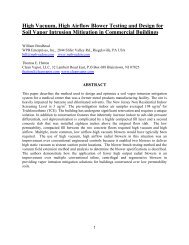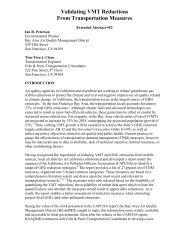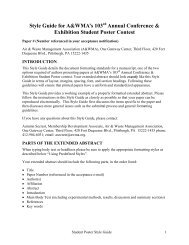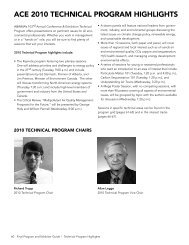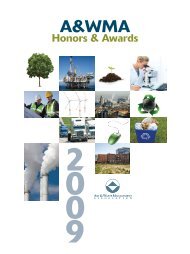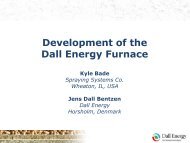Abstract Book
Abstract Book
Abstract Book
Create successful ePaper yourself
Turn your PDF publications into a flip-book with our unique Google optimized e-Paper software.
R. Paine, D. Heinold; AECOM, Westford, MA<br />
U.S. EPA’s recently proposed and promulgated revisions to National Ambient Air<br />
Quality Standards (NAAQS) for PM2.5, SO2 and NO2 provide implementation challenges<br />
regarding the application of dispersion models to assess compliance.<br />
Given that these new NAAQS are substantially lower than the standards they replace, the<br />
customary degree of overestimation that is intentionally designed into the present<br />
Modeling Guideline methods are likely to limit our ability to conduct accurate and<br />
unbiased air quality compliance assessments. Due to the shrinking margin of compliance<br />
associated with these new standards, the skill of regulatory models will be more severely<br />
tested, and refined methods to incorporate background concentrations will need to be<br />
developed. Given that long-term average PM2.5 concentrations have contributions from a<br />
variety of near-field and more distant sources, there is a need for EPA to incorporate the<br />
mechanisms leading to secondary particulate formation into regulatory models.<br />
The promulgated 1-hour standard for NO2 will require more refined methods to estimate<br />
NO to NO2 conversion over short transport distances than is provided in the AERMOD<br />
screening-level methods. Improved methods applicable to urban areas or the vicinity of<br />
major roadways will be required.<br />
The proposed range of the 1-hour SO2 standard is well below the current 24-hour<br />
NAAQS and will test the ability of dispersion models to accurately simulate peak shortterm<br />
concentrations from point sources. Given that there is substantial variability in SO2<br />
emissions due to variability in fuel sulfur content, statistically robust ways of accounting<br />
for this variability need to be explored.<br />
Use Of MODIS Satellite Measurements Of Land Use, Albedo And Leaf Area Index<br />
In CALMET (99)<br />
C. Bell, K. Onder, S. Lataille; Golder Associates, Calgary, AB, Canada<br />
Recent development in the Athabasca Oil Sands Region, located in northeastern Alberta,<br />
has drawn growing concern from stakeholders on the cumulative effects of emissions<br />
from mining and upgrading projects on air quality. In order to assess potential cumulative<br />
air quality changes, refined dispersion modelling is necessary.<br />
The CALPUFF modelling system is currently the model of choice in the Oil Sands<br />
Region. Characterizing the meteorological conditions with CALMET is dependent on<br />
proper definition of the geophysical parameters such as land use, albedo and leaf area<br />
index (LAI). The characterization of these parameters is important for defining the<br />
boundary layer conditions in CALMET. In past air quality assessments completed by the<br />
authors in the Oil Sands Region, land use was derived from the Natural Resources<br />
Canada (NRCan) Land Cover Map of Canada1 for the year 2000 and the geophysical<br />
parameters were assigned based on values from literature and CALMET defaults.<br />
Recently, high temporal and spatial resolution MODerate-resolution Imaging<br />
Spectroradiometer (MODIS) satellite data have become available. MODIS measurements<br />
provide sufficient spectral information to extract land use, albedo and leaf area index<br />
directly at a temporal resolution of two weeks and a spatial resolution ranging from 500<br />
m to 1 km. This study provides a review of the geophysical parameters generated from<br />
18




